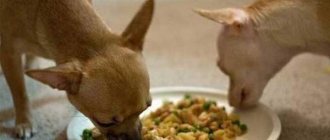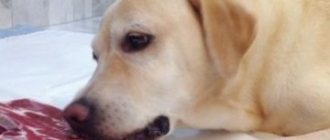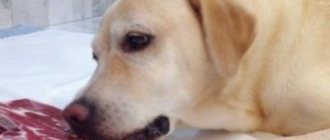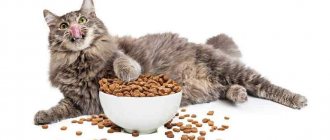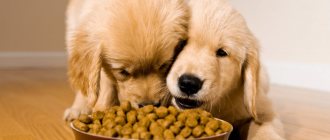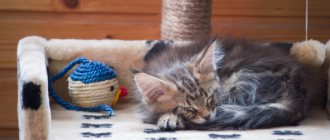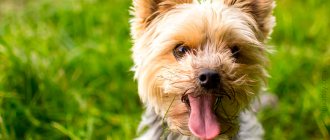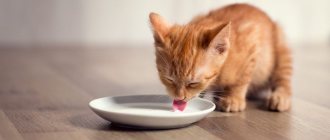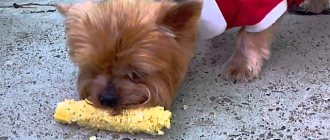The health of the pet directly depends on the quality and clear balance in food for Labrador dogs. In this connection, breeders give preference not to natural food, but to dry food. This trend is not explained by saving time and money, but rather by caring for your four-legged friend. And this decision can be optimal if you know how to choose really high-quality dog food among all the variety of offers that exist today. Reviews from experienced breeders, as well as experts, given below will help you decide where to buy and what to pay attention to.
Bottom line
The above rating is based on many facts - cost, naturalness of the composition, as well as comments from the owners themselves, and so on. When deciding to get a cute puppy, you need to be aware of your responsibility, be prepared to care and worry about the life and health of your pet. That is why you should approach with maximum responsibility the choice of the right balanced diet, which will affect the physical condition and good spirits of your pet. Consultations from specialists and nutritionists from the world of dog breeding play a big role in determining which company’s product is better, but advice from experienced breeders and just amateurs is no less important. Nevertheless, the owners themselves will have to decide which one is better to buy, taking into account not only the popularity of the 2022 models, but also the preferences and needs of their dog, otherwise this may cause intestinal discomfort with all the accompanying problems.
Monthly feeding schedule
The table below shows what a puppy's diet should be by month and how many times a day he should be fed:
| Age | Approximate daily diet | Number of feedings |
| 1 month | meat – 150-200 g, cottage cheese – 50 g, porridge – 50-100 g, milk – 300-500 ml, 1 egg per week, vegetables – about 100 g | 5-6 |
| 2 months | meat – 250-300 g, porridge and cottage cheese – 100-150 g each, milk – 200-300 ml, 1 egg three times a week, vegetables – approximately 100 g | 4-5 |
| 3 months | meat – 350-400 g, cottage cheese – 100-150 g, porridge – 200 g, kefir – 300 ml, 3 eggs per week | 4 |
| 4 months | meat – 450-500 g, cottage cheese and porridge – 200-250 g each, kefir or yogurt – 300 ml, vegetables – 150-200 g | 3-4 |
| 5 months | meat – 500-600 g, cottage cheese – 200-250 g, porridge – 200-300 g, fermented baked milk, yogurt or kefir – 300 ml, fish – 500-600 g, 250-300 g vegetables | 3 |
| from 6 months to 10 months | meat – 500-700 g, cottage cheese – 200-250 g, porridge – 100-250 g, kefir or fermented baked milk – 200-300 ml, fish – 500-600 g, vegetables – about 300 g | 2 |
What is the best food for a Labrador?
The most popular is a dry mixture that quickly saturates the body, maintains the desired level of energy, improves health and prevents problems with the kidneys, liver, and stomach. However, when introducing it into the diet, it is necessary to increase the volume of water consumed by the pet, regardless of what food the Labrador will be fed.
The choice of food is determined by the needs of the animal:
- Active puppies that need a lot of energy can be given Sirius Lamb with Cereal Rice.
- To strengthen a growing dog, it is recommended to use Hill's Science Plan dry mixture based on chicken.
- To avoid gaining excess body weight, especially in dogs prone to this, it is worth introducing Brit Premium with chicken into the diet.
- For ages 1 to 6 years, the best option is Eukanuba Breed Specific, which has a high concentration of animal proteins.
- Royal Canin will help maintain healthy skin and normal coat condition in your Labrador.
- If you have a sensitive stomach and an allergic reaction to grains, you should pay attention to Grandorf rabbit with sweet potatoes and without grains.
- For highly active dogs, you can buy products from the Rodnye Feed brand.
Before choosing any food for your Labrador, it is better to carefully study the product characteristics and reviews about it. Only by comparing the compositions and effects of using the mixture will it be possible to choose a worthy option.
How to choose food for a Labrador
The most valued mixtures are those with a high content of pure meat (beef, turkey, chicken), which are classified as super premium. They increase the amount of proteins and improve the development of the animal. Ideally, it is necessary to take specialized diets designed specifically for Labradors, but there are few of them on the market.
Type
Dog food is divided into dry and wet, which is available in the form of canned food in jars and pieces in bags. The last two are less common. Their advantages are higher calorie content, ease of absorption, improved taste and balanced composition. However, they last less and are not very profitable.
It is better to choose dry food for Labradors in terms of economy; it lasts for a long time and is convenient to store in ziplock bags or in special containers. Their shelf life sometimes exceeds 1 year. It also takes care of the animals’ oral cavity and removes plaque from teeth when chewing granules. Separately, it is worth noting the wide selection for puppies, allergy sufferers, and elderly pets.
Animal age
Food for puppies should contain more meat than for adults, since they need protein for normal development of the body and trouble-free growth. It is also important that the formula contains calcium and phosphorus, which are necessary to strengthen joints and cartilage. You can start giving any mixture only when your pet reaches 2 months.
For puppies and adult dogs under 6 years of age, the calorie intake should be high - at least 3500 kcal. The elderly no longer require as much energy and can buy less filling mixtures with easily digestible carbohydrates.
Package
Ziplock bags, pouches and jars are available in the market in which the canned food is supplied. After opening, any of these packages must be tightly closed to prevent the odor from escaping. Otherwise, the animal will not eat the food with a good appetite.
Special Needs
Special needs include allergies to ingredients (most often oats, wheat, corn, soy), sensitive stomach, impaired digestion, old age or young age under 1 year. Information about this should be indicated by the manufacturer on the packaging or in the product description.
homemade food
By homemade food we never mean food from the human table . At home, you should not give scraps to dogs of any breed, especially such large and active ones. If you decide to feed your Labrador natural food, you will have to create a menu and prepare dog food.
The daily volume is calculated depending on the age, place of residence, condition and activity of the dog. For dogs up to 6 months – 6-8% of body weight; over 6 months – 3-4% of the animal’s weight. For older dogs, 2-2.5% of body weight is enough. The average serving for an adult healthy dog is from 900 to 1400 grams.
The diet is based on fresh meat and meat (fish) products 60%, dairy products and herbal supplements 40%. Fatty meats are not suitable - dogs gain weight very quickly and obesity can develop. It is preferable to focus on the following varieties: rabbit, horse meat, chicken (breast), turkey, veal.
Meat can be taken with veins and cartilage - it is healthier for animals. Keep the tenderloin for yourself. There is no need to cook - just freeze thoroughly in the “deep-freeze” mode and pour over boiling water before serving directly.
What other products should be included when feeding “natural”:
- steamed offal;
- cheese and rye crackers - as a treat and encouragement;
- bifidok, fermented baked milk and yogurt;
- low-fat cottage cheese;
- vegetables – raw, finely chopped;
- raw quail eggs with shell;
- chicken eggs (omelet) 1-2 times a week;
- raw tripe;
- raw beef bone;
- boiled sea fish of low-fat varieties - cleaned of bones;
- complexes of vitamins and minerals.
Read: How to choose vitamins for dogs.
Important! Labradors are prone to obesity, so it is best to avoid cereals, bread and sweet, sugary fruits.
Food for an adult Labrador
These mixtures are based on meat, combined with cereals (wheat, oats, corn), vegetables, berries, fruits, and plant extracts. Adults are defined as animals between 1 and 6 years of age. Older pets are called seniors, and they require their own diet - with a limited amount of calories. The editors of Vyborexperta.ru studied the characteristics of 10 nominees and added 4 of the safest, tastiest, and healthiest to the rating.
Eukanuba Breed Specific
...I fed my puppy this food for six months, the reaction was normal - no allergies, digestion was not affected. The Labrador reacted with an appetite and ate it with pleasure, but upon reaching 1 year old he had to switch to a different diet...
Expert opinion
This is one of the few foods designed to meet the nutritional needs of your Labrador. It is aimed at adult pets aged 1 to 6 years; it is not recommended for puppies. Calorie content of 306.63 kcal per cup meets energy needs and allows you to quickly get enough. This is due to the high concentration of animal proteins - poultry, fish oil, egg powder, cartilage hydrolysate.
The Eukanuba Breed Specific formula also includes plant components - wheat, barley, wheat flour, which increase the nutritional value of the dry mixture and allow you to reduce the serving size. Proteins (23 g) and fats (13 g) are available here, which ensures timely cell regeneration and ensures the normal functioning of the body. Thanks to the inclusion of fiber, digestion is restored.
Advantages:
- Does not harm the kidneys and liver;
- No artificial colors or flavors;
- Not addictive;
- Supports heart function;
- Promotes natural fat burning.
Flaws:
- Only large packages are available - 2.5, 10, 12 and 19 kg.
Eukanuba Breed Specific Labrador dog food supplies the body with omega-3 and omega-6 acids, which maintain healthy skin and shiny coat.
Royal Canin for healthy skin and coat
Another food created for Labradors. It is specially formulated to maintain healthy skin and shiny coat. The minimum recommended age for feeding is 1 year, the maximum is 6 years. The mixture belongs to the premium class, in particular, due to the large amount of meat - poultry and pork. This resulted in a protein content of 30%, which has a positive effect on the immune system, cartilage, and liver.
Royal Canin food is rich in fiber (4.5%), making it especially useful for pets with poor digestion and liver problems. Low fat content (13%) guarantees protection against excess weight gain, and grain crops replenish energy reserves. The composition also includes hydrolyzed cartilage, which strengthens joints. The energy value of the mixture is high - 3710 kcal per 1 kg.
Advantages:
- The animal quickly eats;
- Normal digestion;
- Shelf life – 12 months;
- Can be given to elderly people over 7 years old;
- Does not affect kidney function.
Flaws:
- Gets tired of it after 3-5 months.
Due to the balance of proteins, fats and carbohydrates, the food is suitable for pets prone to excess weight.
Grandorf rabbit with sweet potato
Diet for all breeds of animals, including large ones. This is the only holistic product in the rating, developed based on the needs of the body and taking into account the tendency to allergies. Due to this, the likelihood of digestive disorders, kidney and liver disorders is minimized. The value of the dry mixture lies in the complete absence of grain components; more than 65% is meat.
The grain-free formula is well suited for pets with sensitive stomachs and does not cause heaviness after feeding. The diet is as close to natural as possible. The source of protein, which contains 25% versus 15% fat, is fresh rabbit and turkey meat. Additional ones worth mentioning are spinach, apples, and flax seeds.
Advantages:
- Does not contain dyes;
- Soy and fat excluded;
- Does not include by-products;
- Gentle handling during preparation;
- Vitamin balance.
Flaws:
- Suitable only for adult dogs over 1 year old.
For a Labrador Retriever, the approximate daily food intake is 400-600 g; the more active the animal, the higher it should be.
Native dog food with high activity
Natural ingredients of Russian origin are used in the production of the dry mixture “Native Feed”. We are talking about cereals (wheat and corn), which increase the energy value of the diet and help quickly saturate the body. However, the main component is ground chicken meat and its fat, thanks to which it was possible to achieve a content of 25% protein and 1.5% calcium. They have a positive effect on the skin, fur and bones of the animal.
The food is designed for hyperactive dogs. It is easily digested due to the absence of by-products, flavors and dyes in the composition. This also reduces the risk of developing allergies even in Labradors with sensitive digestion. However, you need to introduce the mixture into the diet gradually (over 7-10 days) and monitor the availability of fresh water. Nutrition includes vitamins A and D3, which are important for vision and joints.
Advantages:
- Made without GMOs;
- A large amount of fiber (3%) improves intestinal function;
- Natural antioxidants that protect against aging;
- Variety of composition, diluted with apples and pumpkin;
- Balanced formula.
Flaws:
- Humidity no more than 10% requires an increase in the amount of water;
- Presence of fat.
The food is suitable for adult dogs over 1 year of age, including older dogs. The mixture is sold in two packages - weighing 2.045 and 16.38 kg.
Meat
A Labrador should eat both raw and boiled meat. Fresh ones are pre-frozen, then thawed and doused with boiling water. By-products are offered to dogs only with heat treatment (cooking).
A Labrador should eat both raw and boiled meat. Fresh ones are pre-frozen, then thawed and doused with boiling water. By-products are offered to dogs only with heat treatment (cooking).
Mineral supplements
The decision on the need for mineral supplements is made together with the veterinarian after assessing the dog’s condition. Labrador retrievers that have problems with skin, fur, teeth, as well as puppies and pregnant bitches require additional saturation with useful substances.
Adherents of a natural diet or budget options for dry food should feed the animal.
Labradors eat with pleasure, so the dog’s refusal of his favorite foods should alert the owner.
Labradors eat with pleasure, so the dog’s refusal of his favorite foods should alert the owner.
Description of the breed
The Labrador breed was officially registered in the 19th century in Britain, where it was brought from Canada. The original name was St. John's. Later, a new name took root - Labrador, or Lab for short. Full name: Labrador Retriever. A dog of large size and extraordinary intelligence. Takes 7th place among dogs in terms of intelligence out of 80 applicants. Can be trained perfectly. The original color is black. Later, the chocolate and fawn generations appeared.
The height of an adult at the withers is no more than 57 centimeters. Dogs are distinguished by powerful paws, drooping ears, and a large head. The body is straight, the loin is wide. The well-set, strong neck and “deep” chest are impressive. The front legs are straight, the hind legs are well developed. The tail is short and thick. The eyes are medium in size, hazel or brown in color. The ears are close to the head.
The character is loving, the mood is always good. They show playfulness and calmness towards people; they will never offend or scare people. Training them is a pleasure. They not only quickly learn commands, but also honestly try not to let their owner down. They get along easily with people and animals. Only birds are not liked, as they are considered hunters.
A real family member, with his own mood and habits. Participates in all important events. Needs communication, but never gets boring with his presence. Carefully observes the mood of those present and does not bother them. A dog can easily be taught to open and close doors, turn lights on and off, and fetch things and slippers. Children dote on them, and the dogs reciprocate. You couldn't find a better nurse and friend for kids.
You need to train your animal regularly. Experts recommend not resorting to punishment for disobedience. The dog will not hold a grudge, but his mood will worsen. Good behavior should be praised, gentle words spoken, and goodies given. If your pet has done something wrong, it is enough to strictly say the word “no”. Intonation will tell your pet that something needs to be changed in their behavior.
The pet does not need special care. It is enough to comb the coat once a week, brush the teeth daily and make sure that parasites do not appear in the ears and dirt does not accumulate. You shouldn't bathe every day. Nails are trimmed once every 10–12 days.
A review of reviews shows that the dog has many more positive characteristics than negative ones, but the latter are worth paying special attention to:
- excessive kindness does not allow the Labrador to become an excellent guard;
- the desire to chew something is constantly present;
- lover of water, even dirty rainwater;
- loves to “bask” in garbage, brings dead mice and birds to the owner;
- snores loudly;
- cannot stand loneliness;
- requires a lot of free space (he is cramped in the apartment).
Weekly diet for a dog weighing 10 kg
| Day of the week | Menu |
| Monday | 200 g cottage cheese, 50 ml kefir, 150 g rice, 250 g meat, 100 g herbs, 200 g vegetables, 1 egg |
| Tuesday | 250-300 ml cottage cheese + milk, 150 g buckwheat, 300 g boiled fish, 100 g herbs, 150-200 g vegetables |
| Wednesday | 250 g cottage cheese + kefir, 150 g rice, 250 g meat, 100 g herbs, 200 g vegetables |
| Thursday | 250 g cottage cheese + yogurt, 150 g oatmeal, 250 g meat, 100 g herbs, 150 g vegetables, 1 egg |
| Friday | 200 g cottage cheese + fermented baked milk, 150 g buckwheat, 300 g meat, 100 g herbs, 200 g vegetables |
| Saturday | 250 ml kefir, 150 g oatmeal, 250 g boiled fish, 100 g herbs, 200 g carrots |
| Sunday | 300 g yogurt, 150 g rice, 250 g fish, 100 g herbs, 100 g pumpkin and beets each |
Vegetables and fruits
Despite the balance of dry food, it is recommended to include fresh vegetables in the dog’s daily menu. There are no restrictions on plant foods for feeding a Labrador, except perhaps individual taste preferences.
Pumpkin, beets, carrots, zucchini are foods that supplement nutrition. Recommended in raw form to preserve the maximum amount of nutrients. You can serve grated or finely chopped; the dressing for such salads is vegetable oil or low-fat sour cream.
Greens are a vitamin supplement to a Labrador's diet. Dill, lettuce, parsley or celery can be chopped directly into the bowl.
It is also advisable to give an adult Labrador fruits and fruits. Most often these are apples, pears, peaches or apricots. Only grapes are prohibited; they will not harm the dog’s health, but will provoke fermentation in the intestines, cause pain and an additional need for walking.
Greens are a vitamin supplement to a Labrador's diet. Dill, lettuce, parsley or celery can be chopped directly into the bowl.
A dog is a carnivore, so its diet should include meat products. It is acceptable to feed a Labrador with beef, horse meat, chicken, rabbit, turkey and even offal. When choosing a delicacy for your pet, it is not necessary to spend extra money on the best cuts; it is much healthier for your dog to eat stringy parts of meat.
